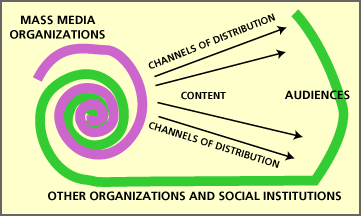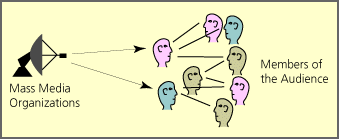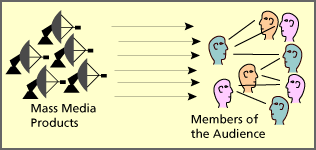

 TUTORIAL: MASS COMMUNICATION
TUTORIAL: MASS COMMUNICATIONINTRODUCTION . TEXT . TEXT AND MEANING . DATA AS TEXT . THE MASS MEDIA . CHANNELS OF DISTRIBUTION . AUDIENCES . MEDIA ORGANIZATIONS . CONTENT . SOCIAL INSTITUTIONS .
The telephone: speech without walls.
The phonograph: music without walls.
The photograph: museum without walls.
The electric light: space without walls.
The movie, radio and TV: classroom without walls.
- McLuhan, 248
The development and widespread use of printed text in Europe in the1500s produced a brand new form of communication. For the first time a single message could be duplicated with little error and distributed to thousands of people. First used to propagate religious texts and arguments, this "mass" approach to communication quickly caught on and was soon being used to distribute news, entertainment, and government regulations.
From these first primitive pamphlets, the "mass media," as they are often called, have grown to include the print media of books, newspapers and magazines, the electronic media of television, radio, and audio/video recording, and the new media of computers and computer networks. While these media differ in many ways, they all share the characteristics by which scholars define mass communication:
Face-to-face communication occurs on many channels, with many opportunities to send and receive messages, and with much complexity in the communication process.

Yet, the situation becomes even more complex when the many media organizations with their production and distribution of millions of messages are considered. Media may be received by millions of people, all of whom are also engaged in face-to-face communication. The intersection of these two types of communication makes for a picture that must include all communicators and their interactions with one another.

The individual parts of this model will be described in more detail. The parts include:
Telephones are electronic media, but telephones have not traditionally been included in the "mass media" because telephones are used mainly in person-to-person communication. Similarly, computers, especially large computer networks, have the potential to be used as mass communication media, however, these are so new that their uses are still developing. Although they have no true category as yet, computers are sometimes referred to as the "new" media.
The following chart illustrates the most common way of organizing the
distribution channels of the mass media. As was noted above, telephones and
computer networks have been omitted because at the present time they are mostly
used as person-to-person, rather than mass, media, and some channels that might
have been included -- posters, flyers, memoranda, filmstrips, slide shows, and
video games, for example -- have been omitted not because they are unimportant,
but because they are not as widely studied as the primary media.
![]() 6012
6012
![]() 6013
6013
|
|
| BOOKS
|
RADIO
|
| NEWSPAPERS
|
TELEVISION
|
| MAGAZINES
|
FILM
|
| DIRECT
MAIL
|
TAPE
AND DISC RECORDINGS
|
A mass medium's distribution channel "aims" a "flow" of messages in the direction of a particular audience. The next two sections will discuss two important aspects of this media "flow."
Books, newspapers, magazines and direct mail are usually read by individuals. Film, on the other hand, is shown in theaters which gather audiences together in fairly large groups. Radio, television, and recordings are often delivered in group settings, but these groups are usually smaller than those who attend the showing of a film, and the three are also often used by individuals.
The relationship between the target audience and the delivery medium are
especially important to commercial media organizations because they must compute the cost and
effectiveness of their media products. In the case of print media, for
example, the price of each book, newspaper or magazine plays a part in a
person's decision to join or not join the audience. Although many people like
to read books, for example, it was only when inexpensive "paperback" books
became available that the audience jumped
to its present size.
![]() 6016
6016
![]() 6034
6034
Media organizations that use advertising to offset their costs must pay
particular attention to their target audiences because their advertisers are
often interested in presenting their ads to particular groups of people. For example, the recent trend in magazine publication has been towards an increase in the number of different magazines each of which appeals to a narrow audience that is desirable to a particular set of advertisers.
![]() 6020
6020
![]() 6021
6021
Availability includes more than equipment. Language also plays a role, as does geographic location and economic class. A radio broadcast in Spanish, for example, is only available to those who speak Spanish. Similarly, printed media are only available to those who are able to read, and cable television will not be available to those who cannot afford the monthly fee.
Media access refers to the ability of members of the society to make use of a particular medium to send messages of their own. Print media is relatively more accessible than broadcast media. For example, anyone who can write can, at relatively little expense, print up and distribute a flyer or newsletter. Access to television and radio broadcast channels, however, is tightly regulated by the government. Even when a channel is provided, as with public access cable television, it is much more difficult and expensive to produce video than to produce print.
Newspapers and magazines traditionally provide public access by means of
"letters to the editor" or "editorial pages." Television and radio news do not
traditionally offer this kind of access. In recent times, however, radio and
television shows featuring listener and viewer "call-ins" have become popular, and this provides access to a large number of people.
![]() 6011
6011
![]() 6022
6022
Access and availability have become increasingly important with the advent of
cable television and the new computer networked media. We might argue that our
society's decision to require all children to attend school and learn to read
has the effect of making the important documents of our society
available to them. Similarly, our society's insistence that everyone
learn to write and our belief in "freedom of the press" encourages citizens to
access the print media.
![]() 6014
6014
As the electronic media have begun to replace the print media as the major
channels for public information, critics have begun to question whether this
societal availability and access will be continued. Government control of the
broadcast channels limits access to these media to large corporations, and
cable television is available only to those who are able to afford the
relatively high cost of connection. These issues are now being widely debated in the United States.
![]() 6023
6023
![]() 6024
6024
In other cases, however, the attention of the audience is spread out over time -- the audience for a particular magazine, for example, may consist of people who read copies of the magazine at various times over the period of a month or more.
And, in some cases, the attention of the audience may be spread over a very long period of time. The audience for Shakespeare's plays, for example, is very large and hundreds of years in duration.
In the early days of mass communication research, the audience was believed to be very passive and innocent. It was supposed that members of the audience believed whatever they read in the newspapers or heard on the radio.
As studies of the relationship between the audience and the mass communication organizations have progressed, the researchers' view of the audience has changed. Nowadays, the audience is believed to be active and sophisticated. That is, the audience chooses the media that it attends to, and the audience is critical of the messages that are delivered to it by the media.

One of the first pieces of evidence that the Magic Bullet Theory was too
simplistic came to light during research that was conducted in the wake of
Orson Welles' famous Mercury Theatre of the Air "Martian invasion" radio
broadcast in 1938. [Note] According to the theory,
anyone who listened to the broadcast should have believed that invaders from
the planet Mars had landed in southern New Jersey. Yet, although some did
believe it, most did not, and the ways in which they came to not believe were
very interesting.
![]() 6010
6010
Some listeners switched channels to see if the news was being carried elsewhere; some picked up the phone and called friends to see if they were listening and if so, to ask what they thought about it; some paid enough critical attention to the show to recognize that it was fiction.
It was clear from these responses that most people did not accept the media
message at face value. Rather, they took it under consideration and gave it
meaning by comparing it to their prior experiences, and in many cases by
talking it over with their families and friends.
![]() 6009
6009
Jeremy Campbell summarizes this result:
The bullet theory assumed that an audience was passive, waiting for the media to shoot a propaganda message into it, and would roll over in a state of docile surrender when hit, as long as the bullet was sufficiently powerful. Accordingly, researchers did not bother to study the audience. Instead, they analyzed the content of the messages, assuming that content was the secret of a successful propaganda bullet. However, the researchers were due for a surprise. The audience obstinately declined to fall under the spell of the messages. Sometimes they reacted in ways that were opposite to the propagandist's intentions, or enjoyed the bombardment without allowing it to change their opinions in the slightest. - Campbell, 197
Once the Magic Bullet Theory was seen to be false, researchers began
to propose alternative theories and design experiments to test them out. This led to the creation of new research methods, and to a sizable growth in the study of mass communication.
![]() 6008
6008
![]() 6026
6026

Theorists hypothesized that certain members of the audience, called "opinion leaders," would be more influential than other members. In theory the opinion leaders would make up their minds as to what the media messages meant and then tell their friends and neighbors.
Research studies conducted to test this hypothesis did find that certain members of the audience were opinion leaders. However, different members were the opinion leaders on different subjects. Because of this, it was (and continues to be) very difficult to find a simple explanation for the spread, or diffusion, of the content of media messages through a society.
Another finding that contributed to the difficulty of explaining diffusion came from the study of rumors. Researchers found that the accuracy of a statement spread by word-of-mouth decreases very rapidly as it travels through a population. Thus, it is hard to see how messages sent to opinion leaders via the mass media could be passed on with any accuracy.
These studies resulted in the conclusion that face-to-face communication is
much more important to the process whereby people form and change their
opinions than the content of mass media messages.
![]() 6028
6028
![]() 6029
6029

The appearance of this approach marks an important change in the way media researchers think about the audience. Previously, they saw the audience as passive -- made up of people who simply accepted whatever was put in front of them. In these models the audience was a captive of the media organizations.
In the uses and gratifications approach the audience is active. Audience members are seen as consumers of a media product, and as with consumers of other goods and services, they shop around, consider alternatives, and make choices.
The earlier approaches assumed that the content of the media must be having some kind of an effect on the audience members, and researchers spent their time trying to locate and measure those effects. However, few substantial effects were ever found, perhaps because the model for the audience was too simplistic.
The uses and gratifications approach seems to provide a richer way of looking at the audience. Instead of asking, "how does the media change our minds?" the uses and gratifications researchers ask "what is the role of media in our lives?"
Here are some examples of the uses to which the media are put:
In this view media becomes just one of many cultural influences in our environment, and far from the most important.